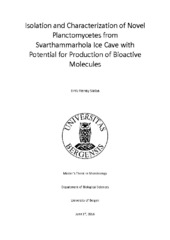| dc.contributor.author | Sæbø, Eirik Færøy | |
| dc.date.accessioned | 2018-08-31T16:19:56Z | |
| dc.date.issued | 2018-08-31 | |
| dc.date.submitted | 2018-08-30T22:00:10Z | |
| dc.identifier.uri | https://hdl.handle.net/1956/18350 | |
| dc.description.abstract | Planctomycetes represent a phylum of bacteria that possess peculiar characteristics. These include reproduction by budding, crateriform structures, rosette formation and an intricate cellular plan. They are considered important contributors in the global carbon and nitrogen cycle and have in recent years been proposed to have potential for various biotechnological applications. The Planctomycetes are ubiquitous bacteria, and has been reported in diverse and extreme environments, both terrestrial and aquatic. These extreme environments include cave ecosystems, as well as ice and glacier ecosystems. However, these reports have been based solely on molecular studies, and no Planctomycetes have been described in axenic culture from either cave or frozen environments. In this study the presence of Planctomycetes in perennial ice from the Svarthammarhola ice cave is elucidated. Drilled ice cores from the distinct layered ice mass were collected. Thawed ice was used as inoculum in enrichments for isolation of Planctomycetes strains. Isolated strains were then subjects for characterization, utilizing molecular and cultivation-based techniques. Four Planctomycetes strains were obtained in axenic culture, and all strains showed both morphological and physiological differences. Phylogenetic analyses of the strains’ 16S rRNA gene revealed that 3 of the strains shared phylogenetic similarities of 99 and 98%, and their closest described species was 90% similar. The fourth strain was 88 and 87% similar towards the other strains, and displayed 90% similarity towards its closest described relative, thus the isolated strains represent two novel genera, within the phylum Planctomycetes. To elucidate the strains’ ability to produce bioactive molecules, two of the strains were screened against the two cancerous cell lines Molm13 and PC3, as well as the normal healthy rat kidney cell line, NRK. Aqueous and organic compounds were extracted from cell cultures and used to treat the cell lines for 72 hours. The cell lines were then investigated for apoptosis induced by the extracts. The screening revealed that the strains were able to produce compounds with intermediate cytotoxicity towards the human AML cell line Molm13. Thus, displaying that the strains might be able to produce bioactive molecules that provide advantages towards other organisms competing for resources in their indigenous environment. | en_US |
| dc.language.iso | eng | eng |
| dc.publisher | The University of Bergen | en_US |
| dc.subject | secondary metabolites | eng |
| dc.subject | cytotoxicity | eng |
| dc.subject | bioactivity | eng |
| dc.subject | Planctomycetes | eng |
| dc.subject | isolation | eng |
| dc.subject | Cancer | eng |
| dc.subject | cave | eng |
| dc.subject | Microbiology | eng |
| dc.subject | ice cave | eng |
| dc.subject | novel | eng |
| dc.subject | extreme environments | eng |
| dc.subject | Bakterier | nob |
| dc.subject | Ekstremofiler | nob |
| dc.subject | Is | nob |
| dc.subject | Bioprospektering | nob |
| dc.subject | Farmakognosi | nob |
| dc.title | Isolation and Characterization of Novel Planctomycetes from Svarthammarhola Ice Cave with Potential for Production of Bioactive Molecules | en_US |
| dc.type | Master thesis | |
| dc.date.updated | 2018-08-30T22:00:10Z | |
| dc.rights.holder | Copyright the Author. All rights reserved | en_US |
| dc.description.degree | Masteroppgave i biologi | en_US |
| dc.description.localcode | MAMN-BIO | |
| dc.description.localcode | BIO399 | |
| dc.subject.realfagstermer | https://data.ub.uio.no/realfagstermer/c005501 | |
| dc.subject.realfagstermer | https://data.ub.uio.no/realfagstermer/c013889 | |
| dc.subject.realfagstermer | https://data.ub.uio.no/realfagstermer/c003143 | |
| dc.subject.realfagstermer | https://data.ub.uio.no/realfagstermer/c008748 | |
| dc.subject.realfagstermer | https://data.ub.uio.no/realfagstermer/c001265 | |
| dc.subject.nus | 751999 | eng |
| fs.subjectcode | BIO399 | |
| fs.unitcode | 12-60-0 | |
| dc.date.embargoenddate | 2019-06-01 | |
